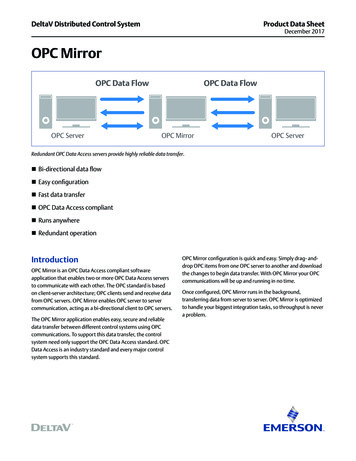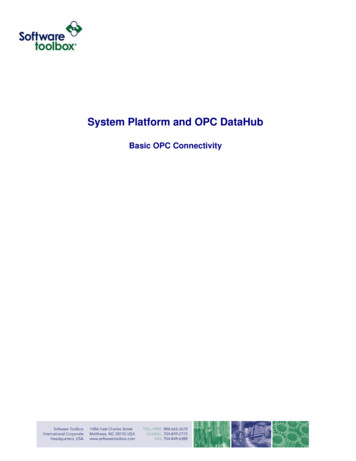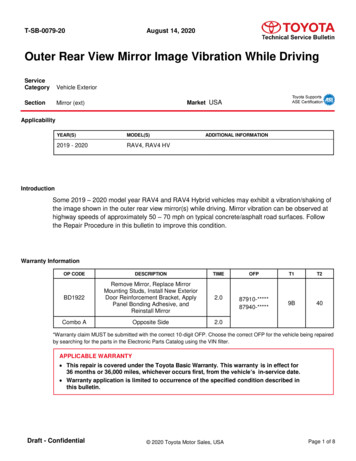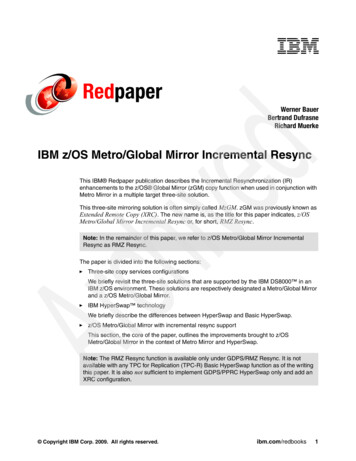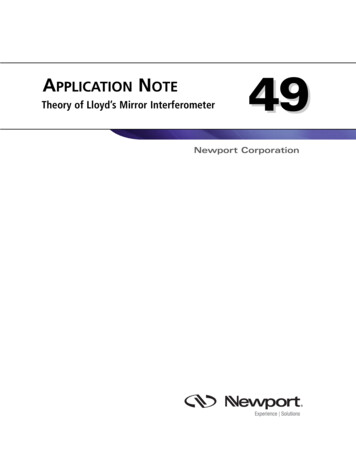
Transcription
DeltaV Distributed Control SystemProduct Data SheetSeptember 2019OPC Mirror RedundancyOPC Data Access Clients and ServersPlant LANSwitch / Router / FirewallApplication Station Pairwith Redundant OPC DA Serversand redundant OPC MirrorPro PlusOp StationApplication StationEthernetControl NetworkRedundant OPC Mirror provides highly reliable OPC Server-to-server data transfer. Enables data transferIntroduction Hardware and software redundancyOPC Mirror is an OPC Data Access-compliant softwareapplication that enables two or more OPC Data Accessservers to communicate with each other. Automatic switchover On-line upgradableOPC Mirror enables easy, secure and reliable data transferamong different control systems using OPC communications.For increased reliability and availability, OPC Mirror can bemade redundant, using an active and a standby instance ofOPC Mirror. Used in conjunction with the redundant DeltaVOPC Data Access servers, you can increase protection againstsingle point OPC Server hardware and software failures.The redundant OPC Mirror resides on a dedicated pairof Application Stations. When the active OPC Mirror fails,the standby OPC Mirror automatically takes over,providing data transfer without user intervention.
OPC Mirror RedundancyBenefitsSeptember 2019Product DescriptionEnables data transfer. OPC Mirror redundancy consists of anactive and standby OPC Mirror. If the active OPC Mirror or itsassociated Application Station detects a failure, the standbyOPC Mirror assumes the active role, providing automaticdata transfer. Your OPC communications will have increasedprotection against unexpected failures.Hardware and software redundancy. The redundant OPCMirror resides on a pair of Application Stations. One ApplicationStation is dedicated to the active OPC Mirror and the otherApplication Station is dedicated to the standby OPC Mirror,providing hardware and software redundancy.Automatic switchover. If the active OPC Mirror or itsassociated Application Station detects a failure, the standbyOPC Mirror assumes the active role automatically, with nouser intervention required. The standby OPC Mirror is in“hot standby” mode, so switchover occurs quickly. Dependingon the failure condition and OPC redundancy configuration,the failed OPC Mirror and Application Station will reboot andautomatically assume the standby role, restoring OPC Mirrorredundancy with no user intervention.On-line upgradable. Since the redundant OPC Mirror resideson a pair of Application Stations, OPC Mirror can be upgradedonline. Just like the DeltaV controllers, you can upgrade thestandby OPC Mirror and its associated Application Station whilethe active maintains OPC communications, then manuallyswitch over to the upgraded Application Station.OPC Mirror provides real-time, read/write data transfer betweentwo or more OPC Servers. For OPC data communications whereyou can’t afford interruptions, the OPC Mirror offers OPC Serverto-Server communication redundancy. You can add a standbyOPC Mirror that operates in hot standby mode, replicating theoperation of the active OPC Mirror. Since OPC Mirror workswith the redundant DeltaV OPC Servers, you can add an activeand standby OPC Mirror to the Application Station pair hostingthe redundant DeltaV OPC Servers to provide DeltaV OPCcommunication redundancy. The active OPC Mirror connectsto the active DeltaV OPC Server and the standby OPC Mirrorconnects to the standby DeltaV OPC Server, for a one-to-one,OPC-Mirror-to-DeltaV-OPC-Server relationship.When a monitored fault is detected, the active OPC Mirrorswitches over to the standby OPC Mirror, which then assumesthe active role. Your OPC communications continue onthe “new” active OPC Mirror. In addition, the DeltaV EventChronicle stores a record of each OPC Mirror switchover andthe reason it occurred, if known.The redundant OPC Mirror resides on a pair of DeltaVApplication Stations. One copy of OPC Mirror must be installedon each Application Station in the Application Station pair.www.emerson.com/deltav2
OPC Mirror RedundancyOPC Mirror redundancy is configured in DeltaV Explorerfrom the Application Station Properties dialog. OPC Mirrorredundancy must be configured with DeltaV OPC Serverredundancy. Then, during DeltaV workstation configuration,you identify the Application Station that will host the initialactive OPC Mirror and the Application Station that will hostthe initial standby OPC Mirror.OPC Mirror redundancy also includes redundant AssignedModules on the Application Station pair. Any control modulesassigned to the Application Station pair are redundant. Landingyour OPC data in control modules running in the ApplicationStation pair enables redundant module execution, just like inredundant DeltaV controllers. When you assign control modulesto execute in the Application Station pair, the redundancysubsystem allows modules running in the standby AssignedModules subsystem to be synchronized with the modulesrunning in the active Assigned Modules subsystem.Although there are two physical Application Stations that hostthe redundant OPC Mirror, they are seen by the DeltaV systemas a single workstation. The Application Station pair is knownby the name configured for the initial active OPC Mirrornode (e.g. REDOPC). The initial standby OPC Mirror nodehas the same name appended with S (e.g. REDOPC S).The Application Station pair appears in the DeltaV Explorersystem tree as a single icon.September 2019By configuring OPC Mirror redundancy, a redundancysubsystem is created on the Application Station pair. Theredundancy subsystem transfers messages and data betweenthe Application Stations, keeping the active and standbyOPC Mirror synchronized. You only need to configure theOPC item mappings on the active OPC Mirror—the redundancysubsystem enables that the configuration is copied to thestandby OPC Mirror.The DeltaV Diagnostics Explorer includes an OPC Mirror andOPC Mirror redundancy subsystem. The OPC Mirror and OPCMirror redundancy subsystems provide diagnostics informationfor OPC Mirror, the OPC Mirror server connections (“pipes”),and the connected OPC Servers, as shown below.The active OPC Mirror and its connected active DeltaV OPCServer work together to provide one-for-one redundancy withthe standby OPC Mirror and its connected standby OPC Server.If a problem is detected with any of the monitored componentson the active OPC Mirror node, the entire Application Stationwill switch over to the standby OPC Mirror node, with thestandby OPC Mirror and the standby DeltaV OPC Serverassuming the active role.DeltaV Diagnostics Explorer allows you to view OPC Mirror redundancy diagnostics data.www.emerson.com/deltav3
OPC Mirror RedundancySeptember 2019When you configure OPC Mirror redundancy, the ApplicationStation itself is not redundant, only OPC Mirror, the DeltaVOPC Server and Assigned Modules subsystem. In addition,the Application Station pair is dedicated to redundantOPC communications. Once the Application Station pairis configured for OPC redundancy, no other subsystemson the Application Station pair may be enabled.Some of the events that can cause a switchover are:When you configure the Application Station pair for the firsttime, you identify the initial active and the initial standby OPCMirror nodes. However, during operation, either ApplicationStation can host the active OPC Mirror, depending on the lastswitchover. Since either OPC Mirror can be the active OPCMirror, each Application Station should be sized to handle theactive OPC Mirror role.The automatic OPC Mirror switchover protects you in the eventof a failure. If the active OPC Mirror fails, the standby OPCMirror automatically becomes the active OPC Mirror. Duringnormal operation, the standby OPC Mirror is in “hot standby”mode, so switchover from the failed active to the standby OPCMirror occurs immediately after the redundancy subsystemhas detected the failure and triggered the switchover. The hotstandby mode adds more load to the DeltaV system but allowsimmediate availability of OPC data after switchover. OPC Mirror failure Connected OPC Server failure DeltaV software processes failure Application Station hardware failure Communications failure between the active and standbyOPC Mirror Communications failure between connected OPC Servers Manual switchover from DiagnosticsFrom the DeltaV Diagnostics Explorer, you can see the status ofthe active and standby OPC Mirror. Indication of the active andstandby OPC Mirror status is also available from a redundancyfaceplate graphic display located in the system tray on theApplication Station pair.During Application Station switchover, which typically takes afew seconds (depending on the Application Station hardwareand the size of the OPC configuration), the OPC data will holdthe last value under the right conditions, enabling a bumplessdata transfer. It is important to say that there are conditionsthat cannot be detected and cause a bump during a switchover.These conditions could be and are not limited to: DCOM errors,synchronous read in the middle of switchover, software bugs,etc. That is why a switchover event is generated and collectedin the DeltaV Event Chronicle, providing notification to theoperator that a switchover has occurred.A failed active OPC Mirror and associated Application Stationwill remain failed by default, waiting for the cause of the failureto be investigated. While the failed OPC Mirror is in the failedstate, switchovers are disabled and the active OPC Mirror is insimplex mode. However, you can configure the ApplicationStation pair to automatically reboot the failed ApplicationStation to allow the failed OPC Mirror to assume the standbyrole without user interaction. A standby OPC Mirror thatassumes the active role will remain the active OPC Mirroruntil the next switchover.www.emerson.com/deltavMirror to the standby OPC Mirror. During switchover, thefailed OPC Mirror will hold last value until the standby OPCMirror assumes the active role. The system can be upgradedwithout losing OPC communications, but as mentioned beforethere are undetected conditions that can cause a bump in thecommunications during a switchover and need to be consideredwhen performing an online upgrade. You can then upgrade thestandby OPC Mirror node at your convenience.4
OPC Mirror RedundancySeptember 2019The active OPC Mirror and the active DeltaV OPC Server resideon the same Application Station. The standby OPC Mirror andthe standby DeltaV OPC Server reside on a second ApplicationStation. A third-party OPC server may be installed on the sameApplication Station as the active OPC Mirror and active DeltaVOPC Server. In this architecture, the third-party OPC servershould also be installed on the Application Station that hoststhe standby OPC Mirror and the standby OPC Server. Doing thiswill prevent data loss when the failed active OPC Mirror switchesover to the standby OPC Mirror, when the failed active OPCMirror, including the third-party OPC server, is shut down.The marshalling of the connection between the third-partyOPC server and the active OPC Mirror is handled automaticallyby the OPC Mirror software. The active and standby OPC Mirrorare monitoring the OPC communications, but only the activeOPC Mirror is transferring data. With a second third-party OPCServer on the second Application Station, failure of the activeOPC Mirror and switchover to the standby OPC Mirror doesnot impact communications to the third-party OPC server,providing bumpless transfer of OPC data under the rightconditions. During switchover, OPC Mirror holds the last goodvalue but as mentioned before, there can also be a bump in theswitchover of OPC mirror due multiple undetected causes suchas: DCOM errors, synchronous read in the middle of switchover,software bugs, etc. Once the standby OPC Mirror becomesactive, real-time OPC communications will resume.Under the right conditions, you can upgrade the ApplicationStation pair online without losing OPC data communicationsbetween the OPC Servers connected through the redundantOPC Mirror. Simply upgrade the standby OPC Mirror node,and then perform a manual switchover. OPC data transfer willswitch from the active OPC.A third-party OPC server may also be installed on a third-partyworkstation. In this architecture, the active OPC Mirror andstandby OPC Mirror will be configured to connect to the remotethird-party OPC Server.The marshalling of the connection between the third-partyOPC server and the active OPC Mirror is handled automaticallyby the OPC Mirror software. The active and standby OPCMirror are monitoring the OPC communications, but only theactive OPC Mirror is transferring data. Failure of the active OPCMirror and switchover to the standby OPC Mirror does notimpact communications to the third-party OPC server. Duringswitchover, OPC Mirror will hold the last good value but a bumpcan occur during switchover for reasons mentioned earlier.Once the standby OPC Mirror becomes active, real-timeOPC communications will resume. In this architecture, thethird-party workstation and third-party OPC server are asingle point of failure; therefore, failure of the third-party OPCworkstation or server will cause a loss in data communications.3rd Party Workstation3rd PartyOPC Server3rd PartyOPC ServerOPC MirrorOPC MirrorDeltaV OPCServerDeltaV OPCServerAssignedModulesAssignedModulesApplication Station Pair (Active/Standby)www.emerson.com/deltav3rd PartyOPC ServerOPC MirrorOPC MirrorDeltaV OPCServerDeltaV OPCServerAssignedModulesAssignedModulesApplication Station Pair (Active/Standby)5
OPC Mirror RedundancyThe redundant OPC Mirror is well integrated with the redundantDeltaV OPC Servers and the DeltaV redundancy subsystem.The redundant OPC Mirror is aware of the status of the DeltaVOPC Servers and will switch over if a problem is detected in theDeltaV OPC Server, communications to the DeltaV OPC Server,or in the Application Station itself. The redundant OPC Mirrormay also be configured to monitor the status of its connectedthird-party OPC servers and act based on the status of the thirdparty OPC servers. The redundant OPC Mirror Server Monitorfeature allows you to configure the redundant OPC Mirror tomonitor the status of the connected third-party OPC serversand switch over if communications are lost between the activeOPC Mirror and the third-party OPC server.From the OPC Mirror Configuration client, you can enableserver monitoring. Once enabled, you configure the desiredswitchover behavior. The options are to switch over if any OPCserver connected to the active OPC Mirror fails or to switch overif all OPC servers connected to the active OPC Mirror fail. Theredundant OPC Mirror Server Monitor feature enables statusof third-party OPC servers to influence the operation of theOPC Mirror redundancy, increasing your OPC communicationreliability and availability.www.emerson.com/deltavSeptember 2019In the example architecture noted above, where a simplexthird- party OPC server is located on a third-party workstation,failure of the network connection between the active OPCMirror and the third-party OPC server would typically resultin a loss of OPC data communications.With the OPC Mirror Server Monitor, the loss of datacommunications due to the failed network connectionwould be detected by the Server Monitor and the activeOPC Mirror would switch over to the standby OPC Mirror.Redundant OPC Mirror is supported only on the DeltaVApplication Station. Simplex OPC Mirror may be used withredundant DeltaV OPC Servers. The simplex OPC Mirror maybe installed on another DeltaV workstation or a third- partyworkstation. The simplex OPC Mirror does not provide theServer Monitor feature included in the redundant OPC Mirror.A redundant OPC Mirror may be licensed for up to 50 OPCserver connections. Each DeltaV system will support up to20 redundant OPC Mirror instances (residing on 20 ApplicationStation pairs). For more information on the Application Station,refer to the Application Station product data sheet.6
OPC Mirror RedundancySeptember 2019Ordering InformationDescriptionModel NumberRedundancy License for OPC MirrorVE2212REDRelated ProductsPrerequisites OPC Mirror. Transfers thousands of values back andforth between your DeltaV system and other OPCcompliant systems. Application Station Software Suite. Integrate your DeltaVsystem with third party systems and applications on a DeltaVworkstation. Includes a scalable DeltaV Continuous Historianand DeltaV OPC Data Access server. Backup and Recovery. Provides data backup anddisaster recovery for DeltaV system and associatedprocess control data. OPC UA. The different OPC UA servers and clients in theDeltaV system allows data reads and writes to and fromthird party application in an easy, reliable and secure way.EmersonNorth America, Latin America: 1 800 833 8314 or 1 512 832 3774Asia Pacific: 65 6777 8211Europe, Middle East: 41 41 768 6111www.emerson.com/deltav One Application Station Software Suite license with theappropriate DeltaV OPC Server scale up, VE2201Sxxxxx(where xxxxx is the number of OPC data values required,from 00250 to 30000). One OPC Mirror license, VE2212Sxxx (where xxx is thenumber of OPC server connections required, from 002to 050). Redundancy License for OPC Data Access Servers,VE2224RED One copy of OPC Mirror installed on each ApplicationStation in the Application Station pair. Two Dell computers (workstation or server class, as required). It is recommended that the Dell computers used for theApplication Station pair be the same model. The Application Station pair used for OPC Mirror redundancymust be dedicated to OPC communications; you cannotenable any other subsystem on the Application Station pairand you should not install or run non-OPC based applicationson the Application Station pair. If you’re using OPC Mirror with non-DeltaV OPC servers, thenyou should follow the instructions provided by the third-OPCserver supplier when configuring the third-party OPC server. DeltaV v10.3 or later. 2019, Emerson. All rights reserved.The Emerson logo is a trademark and service mark of Emerson Electric Co. The DeltaV logo isa mark of one of the Emerson family of companies. All other marks are the property of theirrespective owners.The contents of this publication are presented for informational purposes only, and whilediligent efforts were made to ensure their accuracy, they are not to be construed as warrantiesor guarantees, express or implied, regarding the products or services described herein or theiruse or applicability. All sales are governed by our terms and conditions, which are available onrequest. We reserve the right to modify or improve the designs or specifications of our productsat any time without notice.
the standby OPC Mirror and its connected standby OPC Server. If a problem is detected with any of the monitored components on the active OPC Mirror node, the entire Application Station will switch over to the standby OPC Mirror node, with the standby OPC Mirror and the standby DeltaV OPC Server assuming the active role.
